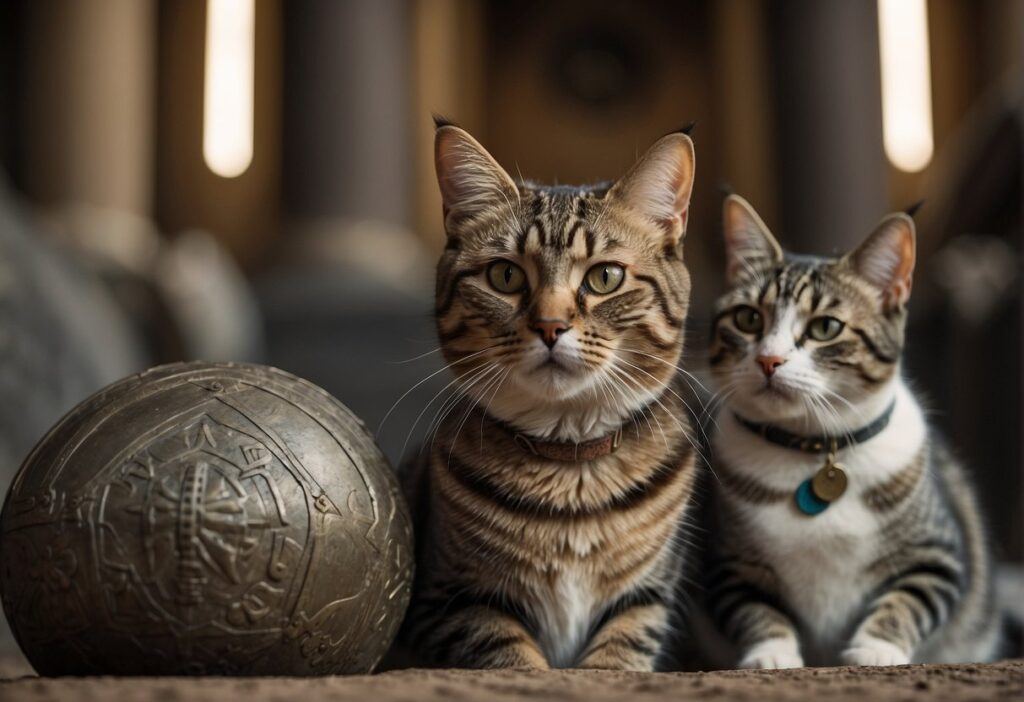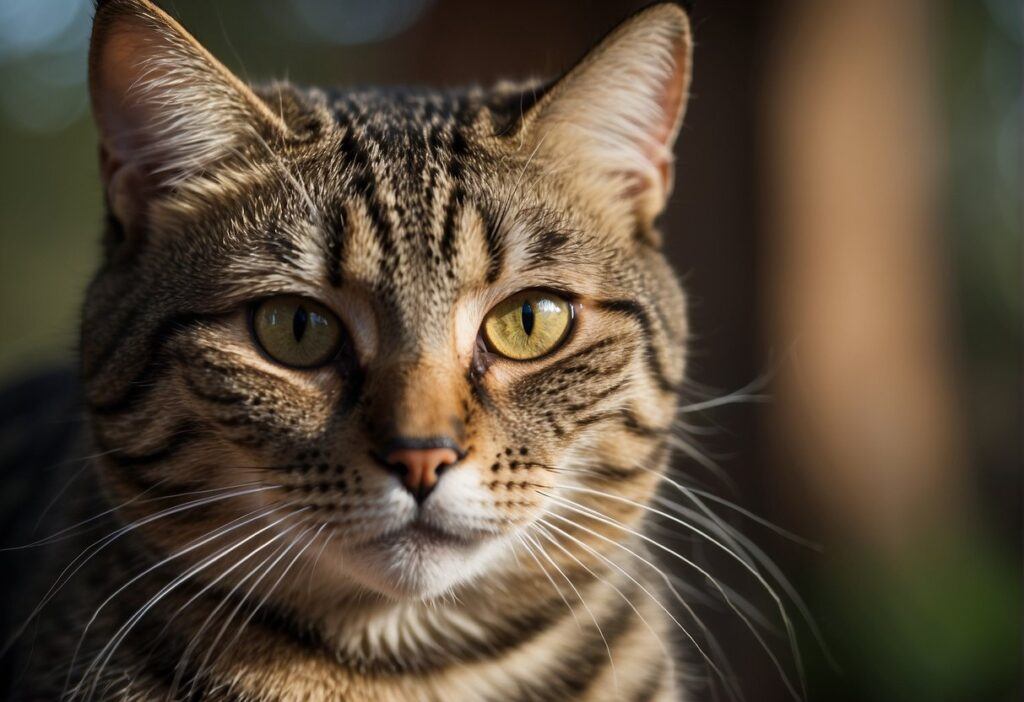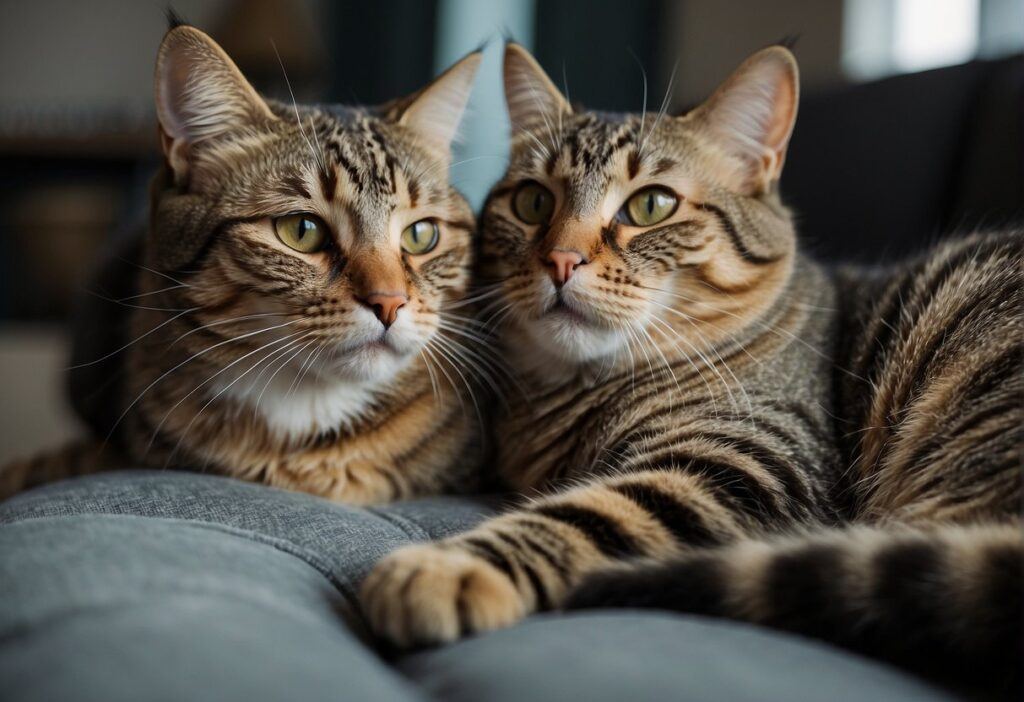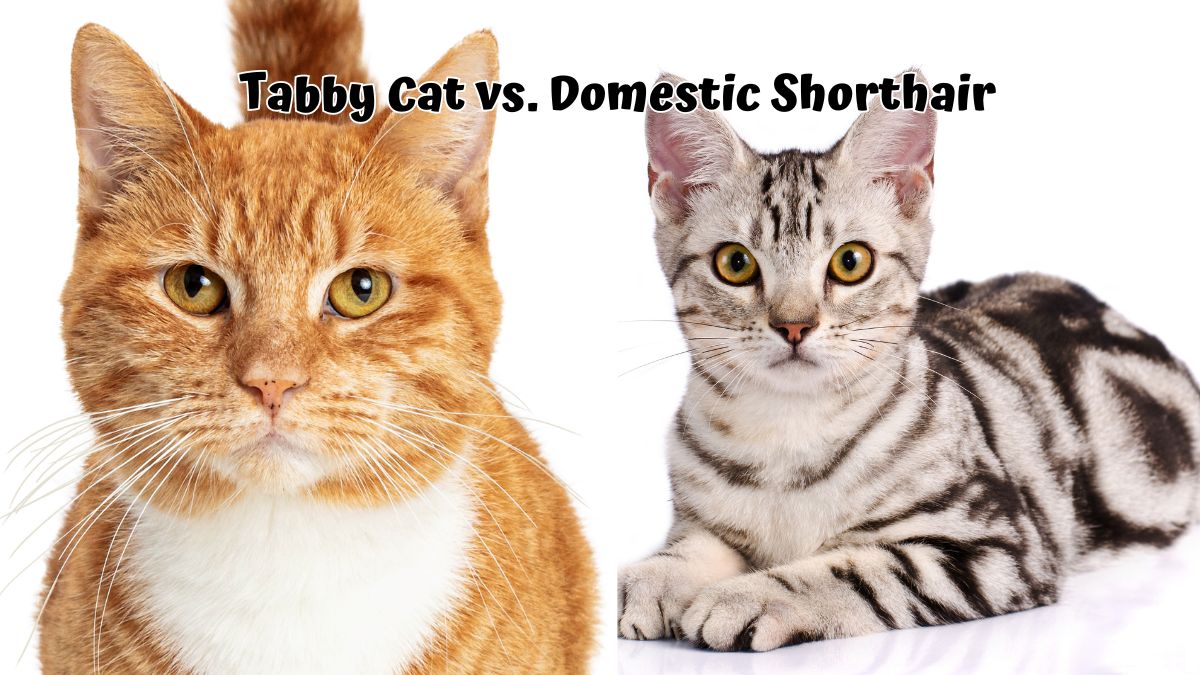When distinguishing between tabby cats and domestic shorthair cats, it is crucial to understand the characteristics that define each group.
Tabby refers to a coat pattern featuring stripes, swirls, and dots with a symbolic ‘M’ marking on the forehead. This pattern is common among domestic cats and is not restricted to a specific breed.
On the other hand, the term ‘domestic shorthair’ describes a breed of cat with a wide variety of coat colors and patterns, including the tabby pattern, and is characterized by a short, sleek coat.
The Cat Fanciers’ Association recognizes various breeds that exhibit the tabby pattern, but the domestic shorthair is not eligible for purebred status as it encompasses a diverse gene pool.
Despite this, domestic shorthairs are one of the most prevalent cat types in the United States.
Understanding the differences and similarities between tabby cats and domestic shorthairs is essential for cat enthusiasts and prospective cat owners to make informed decisions regarding adoption and care.
Tabby Cat vs. Domestic Shorthair

Domestic shorthair and tabby cats represent a rich tapestry of feline history marked by natural evolution and selective breeding across various regions.
Evolution of Domestic Shorthair and Tabby Cats
The domestic shorthair cat is a non-pedigreed, versatile breed with a diverse gene pool since it was not developed through deliberate human-crafted breeding efforts.
Tabby is not a breed but refers to the distinctive coat pattern expressed in many cat breeds, including domestic shorthairs.
The evolution of these cats is closely linked to their roles as pest control and companions, dating back to when they began living alongside humans, particularly in ancient civilizations such as Egypt.
Ancient Egyptians may have been one of the earliest societies to domesticate cats, recognizing their utility in protecting granaries from rodents.
The tabby pattern results from natural selection, with the various stripes, whirls, and spots providing camouflage and stealth in different environments, aiding in their survival and hunting capabilities.
This camouflage attribute was pivotal to their proliferation across multiple continents.
Breed Development in Different Regions
In North America, several official breeds have emerged from the domestic shorthair population, including the American Shorthair and the Maine Coon.
The American Shorthair is specifically bred for its gentle temperament, robust health, and varied coloring, often including the tabby pattern.
This breed was refined over centuries, beginning with the working cats brought over by early settlers to protect food supplies from rodents.
The British Shorthair, developed in the United Kingdom, is another example of region-specific breed development, with a denser coat and more rounded features.
It is similar to the American Shorthair in terms of being a well-muscled, healthy breed.
In Egypt, the Egyptian Mau is a direct descendant of cats from ancient times, and it is revered for its spotted tabby coat pattern and graceful demeanor.
The development of domestic shorthair cats and their variants within different regions reflects a relationship with human society influenced by natural migration patterns and specific human breeding objectives to create various breeds suited to diverse environments and preferences.
Breed Characteristics

Understanding the physical attributes and variety in coat patterns allows for better recognition of tabby cats and domestic shorthair breeds.
Physical Features
Domestic shorthair cats are known for their diversity in physical features, ranging from round heads and short legs to larger ears and varied body sizes.
In contrast, certain pedigree breeds, such as the American and British Shorthair, exhibit specific traits like sturdy builds and consistent facial structures.
- American Shorthair: Round face, short legs, large ears
- British Shorthair: Round head, cobby body, dense coat
Tabby cats aren’t a breed but display distinct patterns that can occur in different breeds. They often have muscular builds and robust facial features.
Coat Patterns and Colors
Tabby cats are characterized by their unique coat patterns:
- Mackerel Tabby: Narrow stripes running parallel down the sides
- Ticked Tabby: Each hair is striped with alternating light and dark bands
- Classic Tabby: Swirling patterns resembling a marble cake
- Spotted Tabby: Spots all over the sides
- Patched Tabby: Combination of tabby patches and another color, often seen in calicos
Domestic shorthairs exhibit various colors and patterns due to their mixed ancestry. Here are a few examples:
- Solid Colors: All white, black, or other solid colors.
- Calico and Tortoiseshell: Mixture of orange, black, and white in calico cats and black and orange mottling in tortoiseshells.
- Tuxedo Cats: Black with white markings on the chest and paws.
Their short coats lend to their name, and these cats can showcase any tabby pattern.
Rather than having a long, flowing coat, these cats are more practical in their grooming needs due to their short hair.
Health and Maintenance

When comparing tabby cats to domestic shorthairs, understanding their care requirements and common health concerns is essential for maintaining their well-being.
Care Requirements
Domestic shorthair cats are known for their low maintenance in grooming. They typically require less grooming than many purebred cats due to their short coat, which don’t mat or tangle easily.
Regular brushing can help reduce the amount of loose hair and minimize hairballs.
While they don’t need frequent baths, brushing a couple of times a week is beneficial to remove dead hair and distribute natural skin oils.
- Physical Activity: Both tabby and domestic shorthair cats require daily exercise to stay healthy. Provide various toys and engage in interactive play to help them stay active.
Common Health Concerns
While domestic shorthair cats generally enjoy good health due in part to their mixed genetic background, they can still experience issues common to all domestic cat breeds.
Regular veterinary check-ups are crucial to catch any health problems early.
| Health Issue | Tabby Cats | Domestic Shorthairs |
|---|---|---|
| Obesity | Can occur in low-activity cats; monitoring diet is important. | Same as tabby cats, they benefit from a diverse gene pool. |
| Dental Disease | Requires regular teeth cleaning to prevent. | Like tabby cats, dental care is essential. |
| Genetic Disorders | Fewer in mixed breeds compared to purebreds. | Same as tabby cats; benefit from a diverse gene pool. |
- Coat Health: The health of a cat’s coat can be a good indicator of their overall wellbeing. A shiny coat without bald patches typically signifies a healthy cat. Regular grooming helps identify any skin issues early.
Behavior and Temperament

Domestic shorthair cats and tabby cats exhibit various personality traits that can influence their behavior and how they adapt to different environments.
Common Traits
Both domestic shorthair cats and those with tabby markings share certain common personality traits. While individual cats can have their unique characteristics, they often showcase playfulness and curiosity.
- Playful: These cats enjoy interactive play, with cat toys and trees often being the best way to engage them.
- Curious: A new cat in the household will generally explore their new environment thoroughly.
- Social: Many of these cats are adept at forming strong bonds with their pet parents and can live comfortably as indoor cats.
Pet parents should observe their cats closely to learn each cat’s unique temperamental nuances.
Adaptation to Environments
Adaptability is a hallmark of both domestic shorthair and tabby cats, explaining why they’re often chosen as companions:
- Indoor Adaptability: Well-suited for living indoors, they typically adjust well to the life of an indoor cat, provided they have sufficient stimulation.
- Outdoor Considerations: Some become barn cats in rural settings, showcasing resourcefulness and natural adjustment ability.
- Different Personalities: Each cat showcases different personality traits, so one domestic shorthair might be more independent, while another may be more affectionate.
Related: Tabby vs Tiger Cat: Understanding the Differences and Characteristics
Cultural and Societal Impact
The presence of cats, particularly tabby cats, and domestic shorthairs, has a pronounced influence on various aspects of society and the familial dynamic.
Cats in Society
Tabby cats, with their distinctive striped or marbled patterns, are often ubiquitous in many cultures and are sometimes even considered the archetypal alley cat.
They have a strong presence in urban environments that can be crucial in controlling the rodent population.
Cats, in general, including domestic shorthairs, which are often referred to as the mutts of the cat world, do not have a single defining look, making them a diverse group loved by cat enthusiasts.
The popularity of certain breeds like the Maine Coon or the Scottish Fold often circulates through media, influencing the image credit these breeds receive in society.
- Role in Population Control:
- Cats are natural hunters, which is beneficial for keeping rodent populations in check.
- Cat Lovers and Breeds:
- Among the breeds of cats, the Maine Coon and the Scottish Fold are particularly admired, symbolizing pure breeds, as opposed to the widely varied domestic shorthairs.
- Cats and Licensing:
- Some regions have specific licensing agreements or regulations set by authorities such as the Financial Conduct Authority to ensure responsible pet ownership.
Cats in the Home
Within the domestic setting, cats are cherished companions. The domestic shorthair cat’s personality varies widely. These house cats adapt to family life with ease.
Orange tabbies and domestic longhairs also enjoy popularity in homes. Still, the American Shorthair kitten is often seen as the quintessential pet for the average American family.
Domestic shorthairs, while not always pure breeds, could be considered one of the most popular cats due to their adaptability and varied temperaments that suit different households.
- Household Dynamics:
- Cats often adjust to home life, becoming integral to the family unit.
- Common Breeds in Homes:
- American Shorthair: Often chosen by families for its temperament and compatibility with home life.
- Tabby Cats and Domestic Longhairs: These cats are also prevalent in homes with distinct patterns and coat lengths.
Comparing Specific Breeds
One must consider genetics and recognition standards when exploring the world of feline breeds.
Tabby Cat Versus Other Breeds
The “tabby” designation refers to a coat pattern, not a breed. This pattern is characterized by stripes, swirls, and spots and is found in many cat breeds.
The tabby pattern features the agouti gene, which controls the appearance of these patterns on the fur.
Some breeds where the tabby pattern is prominent include:
- Turkish Van: Known for its distinct color patches and often sporting a classic tabby pattern.
- Norwegian Forest Cat: A breed exhibiting the tabby pattern with a robust build and long, dense coat.
- Bengal Cat: This breed, resembling a wild leopard, often showcases a rich, spotted tabby pattern.
While the tabby pattern is prevalent, specific breed traits such as body shape, temperament, and breed standards set these purebreds apart from mixed-breed tabbies.
Domestic Shorthair Versus Other Breeds
Domestic Shorthair (DSH) cats are mixed-breed cats with various coat colors and patterns. They are not a specific breed but a classification of any shorthaired cat without a pedigree.
In contrast:
- Purebred American Shorthairs: Recognized for their well-defined and consistent breed standard.
- British Shorthair: A specific breed known for its dense coat and stocky physique, distinguishable from Domestic Shorthairs.
- Russian Blue: Exhibits a distinct short, bluish coat with a shimmering sheen, unlike the varied coats of Domestic Shorthairs.
American Shorthair cats represent a recognized breed with specific traits and historical lineage. Meanwhile, Domestic Shorthairs encompass many traits and lack breed recognition.
Introducing Cory Haasnoot, a devoted father, loving husband, and enthusiastic cat lover. As a key content creator for CatFurLife.com, Cory blends his family values and passion for felines into engaging and informative content. He brings a unique perspective to the site, sharing cat care tips and how cats can enrich family life and bring joy to households.

